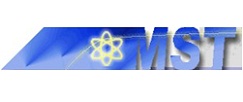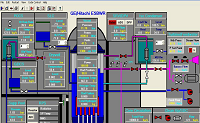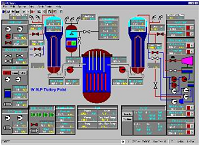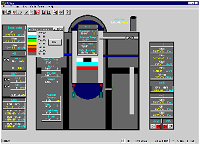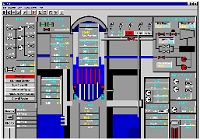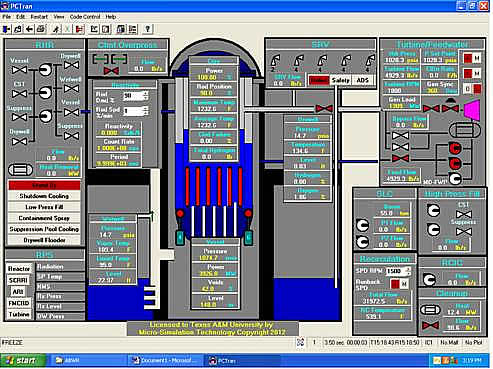Radiation Protection
MICRO-SIMULATION TECHNOLOGY
************************************************************************************
GE/Hitachi Economic Simplified BWR
GE/Hitachi Economic Simplified BWR
ESBWR
- The General Electric Economic Simplified BWR (ESBWR) relies on the use of natural circulation and passive safety features to enhance the plant performance and simplify the design. It was based on the earlier Simplified BWR (SBWR) by economics of scale to a higher power level of 4500 MWt (1560 Mwe). The use of recirculation pumps in previous BWR models or reactor internal pumps for ABWR is completely eliminated. Core flow is by natural circulation.
Normal operation is by the control rod drive system. Since there is no circulation pump for the core flow control, the flux-flow map is a simple natural circulation curve. Setting the header pressure set point in the upper right panel provides turbine header pressure control. The reactor coolant Cleanup system and Shutdown Cooling system are provided in the lower right panel. Operators should control the turbine bypass valves to lower the reactor pressure below the low-pressure RHR pumps’ shutoff head. After that the Shutdown Cooling System can be turned on for cool down to cold shutdown. The cooldown rate must be controlled within a Technical Specification’s rate limit. Natural circulation is further used for emergency core cooling and containment cooling. In the event of steam line leak or break, the reactor is shutdown by inserting all control rods from the bottom. The feedwater continues to maintain the water level in the vessel.
The core and containment cooling systems are completely "passive", i.e. without using AC-driven pumps and controls. It is demonstrated in GE's website by clicking the "ESBWR Passive Safety Systems Animation" link. Our PCTRAN/ESBWR is the first simulator in the world that has reproduced the video's animation with high fidelity. Not only the loss-of-coolant-accident (in this case a steam line break) in the video was quantitatively reproduced, but also every category in the vendor's design documentation could be benchmarked to reach reasonable agreement. You may download the attached demo version and verify it yourself. Download the free demo. - Operator and Technical Staff Training
- Engineering and Design Analysis
- Probabilistic Risk Assessment
- Normal operation control - startup, shutdown, power ramp
- Loss-of-coolant-accident or steamline break
- Loss of flow or recirculation pump trip
- Turbine trip with/without bypass
- Station blackout or loss-of-load
- Inadvertent rod withdrawal or insertion
- Boron dilution transient
- Steam generator tube rupture (PWR)
- Feedwater transients
- Anticipated transient without scram (ATWS)
- Normal operation control ‑ startup, shutdown, power ramp
- Loss‑of‑coolant‑accident (LOCA) or steamline break
- Loss of flow, single or two‑phase natural circulation
- Turbine trip with or with bypass, station blackout
- Steam generator tube rupture (PWR)
- Feedwater transients
- Anticipated transient without scram (ATWS)
- Damage to containment or spent fuel storage facility (for example, caused by earthquake or airplane crash)
- Loss of onsite and/or offsite power, fire or flood (tsunami)
- Any combination of above
- GE BWR 2-6, ABWR and ESBWR
- Westinghouse 2, 3 and 4-loop PWR with dry or ice condenser containment
- Westinghouse Generation 3 passive ECCS and containment AP1000
- Korean Standard Nuclear Plant OPR1000 and APR1400
- Areva PWR’s , EPR 1600, ATMEA1 PWR 3-loop, Mitsubishi APWR
- Russian VVER-440 and 1000 and 1200 of horizontal steam generators
- One of plant type PCTRAN executable program
- Theory Manual, User's Manual and Reference Plant Verification Report
- One-year of hot-line technical support
- Your plant specific PCTRAN executable program and database
- Theory Manual, User's Manual and your plant's FSAR Verification Report
- All above plus core-melt and containment failure models
- Verification against test data or other severe accident code analyses
- Radiation release source term extended to trans-uranium and rare earth isotopes
- Plume and puff release dose projection with variable wind speed and direction
- Plant specific map marked with thyroid and integrated doses
PC-based Nuclear Power Plant Simulator
Personal Computer Transient Analyzer
PC-based Nuclear Power Plant Simulator
Severe Accident Management .
PCTRAN is a software package that can simulate a variety of accident and transient conditions for nuclear power plants. It operates in the Windows XP environment at a speed faster than real-time. A high-resolution color mimic of the Nuclear Steam Supply System (NSSS) and containment displays the status of important parameters and allows simulation of operator actions by interactive control.
Transient Simulations
The user can select from a set of initial conditions corresponding to various power, flow, and time-of-life conditions of the plant. By using the mouse, the user can choose from auto or manual mode of plant operation. He or she can also initiate malfunctions that encompass all possible disturbances to a plant and all categories analyzed in the plant's FSAR. For example:
Any combination of above.
A plant mimic as shown in the figures will be displayed on the screen as computation is progressing. Selected key plant parameters are digitally displayed in real-time or faster, if selected. Water levels dynamically rise and fall as calculated and coolant void fraction is reflected by changing colors. Other dynamic indicators show the status of pumps, valves, trips, and alarms, as well as control rod movement.
PC-based Nuclear Power Plant Simulator
PCTran is PC-based reactor simulation software that conducts nuclear power plant transient predictions at a speed faster than real-time. The plant model presented in this version of PCTran is of the ABWR designed for the Taiwan Power Company's Fourth Nuclear Power Project Lungmen.
The main screen displays a mimic of the Nuclear Steam Supply System with panels of controls for the most important equipment.
PCTRANã Nuclear Power Plant Simulator
Micro-Simulation Technology
10 Navajo Court
Montville, New Jersey 07045
1 973 263 7327
1 973 402 9456 Fax
http://www.microsimtech.com
PCTRAN is a PC-based nuclear simulation package specifically designed for training in plant operation and accident response. Severe accidents such as core-melt, containment failure and radiological release are within its scope. Since its introduction in 1985, PCTRAN has become the most successful training simulator installed at nuclear powers and research organizations all over the world. Since 1996 it was selected by the International Atomic Energy Agency as the training tool in its annual Advanced Reactor Simulation Workshop. Scores of universities have used PCTRAN for teaching nuclear technology as well as the platform for Master and PhD thesis development.
In the plant mimic, instrumentation and control are provided for normal plant operation. In addition, there are icons showing reactor coolant boundary leakage or containment failure. The combined radiological releases contribute to dose distribution in Emergency Planning Zone. PCTRAN prepares a nuclear power plant’s personnel with realistic training and exercise. The simulator extends to area dose projection according to live meteorological conditions. Its speed can be either real-time or many times faster. Operation is user-friendly in its graphical-user-interface (GUI). All graphics, text messages and data are transmitted using Microsoft Office Suite.
Advancement into Generation III advanced plants using passive cooling concept, MST is the sole supplier to provide simulators for ALL plant types including GE ABWR, ESBWR, Westinghouse AP1000, Areva EPR, Atmea1 or Mitsubishi APWR, Russian VVER and Korean OPR and APR. Everyone is validated and verified against the vendor’s Designed Document to ensure its fidelity.
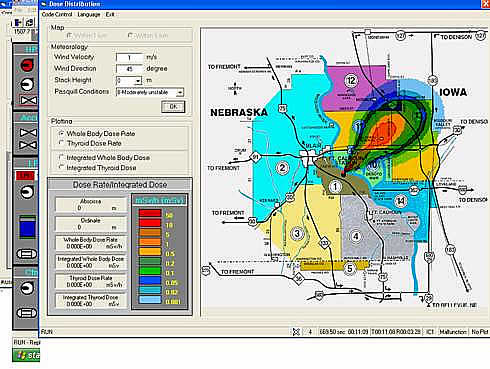
Transient Simulations
Selection of a transient is menu‑driven that includes all possible disturbances to a plant such as:
Severe Accident Model
The core is modeled into six vertical nodes. Each one will generate a portion of the decay heat. When the boundary heat removal rate is less than the core heat, the core node is heated up to the point of melting. Molten fuel may collapse into the bottom of the vessel. The vessel lower head may then heat up to the melting point, too. The molten debris may drop into the containment cavity floor. During the fuel damage process, first the fission gas in the clad may leak out. Later if the fuel and cladding continue their degradation, fuel isotopes will release also. In addition to iodine and noble gases, there are alkali metals, tellurium, barium, cerium, lanthanides, etc. The elevated concentration of these radioactive isotopes would find their ways through the vessel break, relief valves, and containment leakage into the environment.
PCTRAN is most powerful in its versatile and interactive control. The user can at any time manually trip the reactor or the pumps, open or close a relief valve, override the ECCS or change the set points for a number of the control systems. All transient parameters are available for trending during execution or printed after the run. The data can be saved in Access or Excel files for later usage. The restart capability can virtually extend a transient simulation to indefinite time period.
RMS Source Term & Area Dose Projection
Available as an option, the extended simulation model keeps track of fission product transport along the major release pathways. Normal and accident condition readings of major area, effluent, and process radiation monitors throughout the plant are displayed in a separate mimic. Iodine, noble gases and other fission products based on Regulatory Guide 1.183 Revised Source Terms are calculated periodically. Plume or puff release is then projected for variable wind speed and stability factors in the Emergency Planning Zone.
Available Plant Models
MST has completed the following models in Windows:
The above models are “plant specific” with best effort to duplicate the plant’s design and performance. Detailed documentation was prepared in modeling methodology and verification against the plant’s FSAR and known data. The software has been installed at the government regulatory agencies of US, Japan, Switzerland and Taiwan and over one hundred facilities in the world.

PWR Severe Accident (Core-melt, Containment Failure and Radiological Release)
GE/Hitachi/Toshiba ABWR
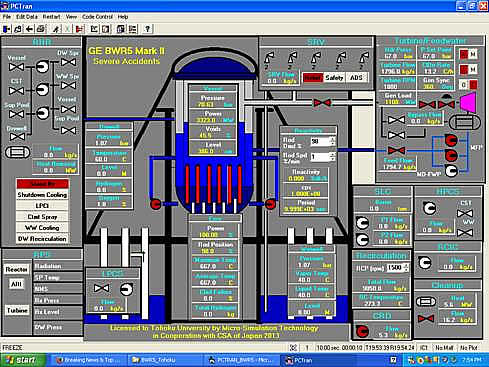
GE BWR5 Mark II
Computer Configuration
Any Pentium or compatible PC with SVGA graphic monitor and color printer is required. The operating system should be Windows XP, 7 or 8 with MS Office Suite installed. Simulation speed is adjustable from real‑time to fast time. For a 1.4 GHz processor, the maximum speed is about 16 times faster than real-time.
Free Demo Download
Full capability demonstration packages are available for download at MST’s website http://www.microsimtech.com/downloads/default.htm
APPLICATIONS
Training – A Training Simulator for operators and engineers training in reactor theory, transient phenomena and diagnostic skills. A comprehensive training lesson plan from basic principles to symptom oriented emergency diagnosis can be developed in conjunction with the software.
Emergency Exercise – Generate emergency drill scenarios and conduct actual exercises. Data at selected time interval can be prepared and handed out to drill team for an undisclosed event. Data on core damage, radiological release and offsite dose projection support a comprehensive exercise.
Application Analysis – Parametric/Scoping Study
For system modifications and licensing support, development of emergency procedures, responding to regulatory inquiries such as system performance, equipment sizing, operator actions, etc., repetitive runs can be conducted with immediate turnaround for answering “what if” type of questions.
Probabilistic Risk Assessment (PRA) – To predict consequences of selected event branches leading to core melt and/or containment failure, and their contributions to overall plant risk.
PCTRAN License
Package |
Contents |
Basic (NSSS, containment and radiological dose) |
|
Plant Specific |
|
Severe Accident |
|
Dose Projection |
